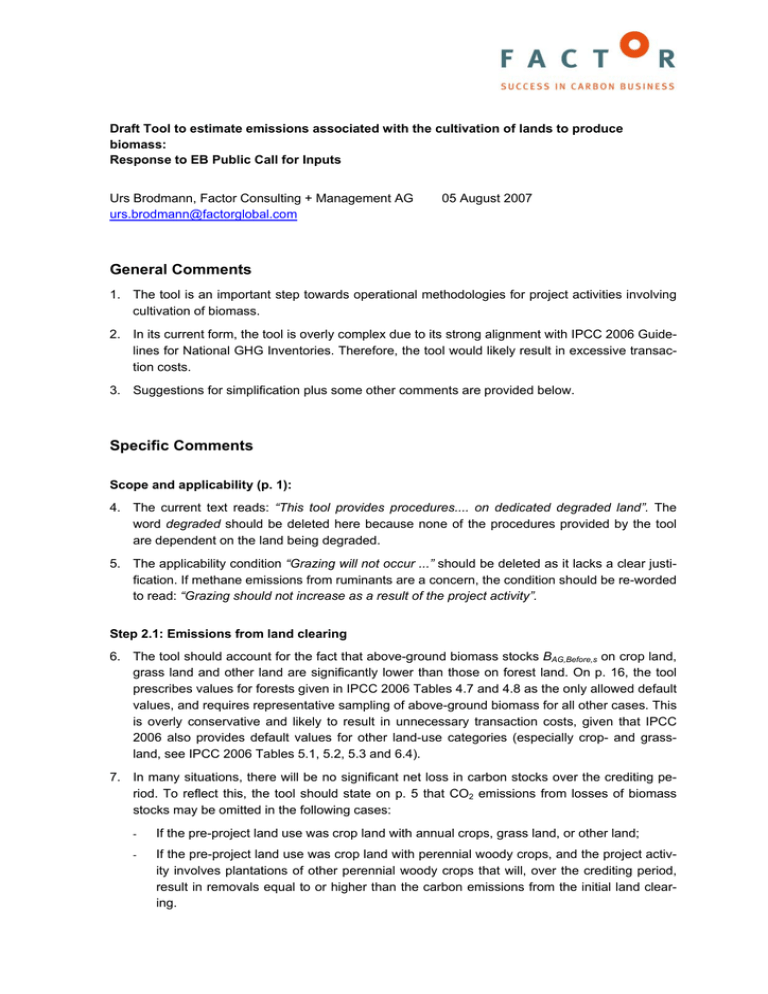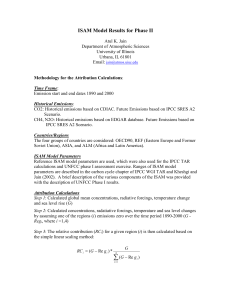Document 11119227
advertisement

Draft Tool to estimate emissions associated with the cultivation of lands to produce biomass: Response to EB Public Call for Inputs Urs Brodmann, Factor Consulting + Management AG urs.brodmann@factorglobal.com 05 August 2007 General Comments 1. The tool is an important step towards operational methodologies for project activities involving cultivation of biomass. 2. In its current form, the tool is overly complex due to its strong alignment with IPCC 2006 Guidelines for National GHG Inventories. Therefore, the tool would likely result in excessive transaction costs. 3. Suggestions for simplification plus some other comments are provided below. Specific Comments Scope and applicability (p. 1): 4. The current text reads: “This tool provides procedures.... on dedicated degraded land”. The word degraded should be deleted here because none of the procedures provided by the tool are dependent on the land being degraded. 5. The applicability condition “Grazing will not occur ...” should be deleted as it lacks a clear justification. If methane emissions from ruminants are a concern, the condition should be re-worded to read: “Grazing should not increase as a result of the project activity”. Step 2.1: Emissions from land clearing 6. The tool should account for the fact that above-ground biomass stocks BAG,Before,s on crop land, grass land and other land are significantly lower than those on forest land. On p. 16, the tool prescribes values for forests given in IPCC 2006 Tables 4.7 and 4.8 as the only allowed default values, and requires representative sampling of above-ground biomass for all other cases. This is overly conservative and likely to result in unnecessary transaction costs, given that IPCC 2006 also provides default values for other land-use categories (especially crop- and grassland, see IPCC 2006 Tables 5.1, 5.2, 5.3 and 6.4). 7. In many situations, there will be no significant net loss in carbon stocks over the crediting period. To reflect this, the tool should state on p. 5 that CO2 emissions from losses of biomass stocks may be omitted in the following cases: - If the pre-project land use was crop land with annual crops, grass land, or other land; - If the pre-project land use was crop land with perennial woody crops, and the project activity involves plantations of other perennial woody crops that will, over the crediting period, result in removals equal to or higher than the carbon emissions from the initial land clearing. Step 2.3: Changes in soil carbon stocks 8. Emissions from soil carbon are unlikely to be significant if the soils are severely degraded prior to establishing the biomass plantation. On p.6, therefore, the tool should state that emissions from soil carbon may be omitted in the following cases: - If no land use change or change in land management practices is introduced with the cultivation of the biomass under the project activity, OR - If the plantations are established on severely degraded land (forest-, crop-, grass- or other), and the soils are not organic. 9. Definition of “severely degraded” should be provided. Step 2.6: N2O emissions from land management 10. Parameters in Eq. 18 (N in crop residues) should be aligned with Eq. 6 since both relate to crop residues. 11. The tool should allow to omit N in crop residues if it can be shown that the input of residue N in the project scenario is unlikely to differ substantially from the input in the pre-project situation or baseline scenario. This is to reduce transaction costs related to monitoring. 12. The section on indirect N2O emissions should be deleted completely, for the following reasons: - The current approach effectively double-counts N2O emissions: First, the direct emission factor EFN2O-N,dir is applied to the full N input entering the plantation (Eq. 15). Second, fractions of the total N input are assumed to volatilize and leach, resulting in N2O emissions elsewhere. While this is consistent with IPCC 2006, it lacks a clear logic since volatilization and leaching typically occur shortly after N application, i.e. before microbial conversion (and associated direct N2O emissions) can take place. - Leaching will occur only in regions where the water holding capacity of the soil is exceeded (and on the condition that the N is applied during this period). In other regions, FracLEACH is zero. See IPCC 2006, Tab. 11.3. - If indeed the overall (direct + indirect) conversion rate to N2O is higher for some N sources than for others (e.g. organic manure vs. residue N), corresponding weights should be introduced in Eq. 15, rather than having a separate section on indirect emissions. This will make the tool more user-friendly. 2/2







